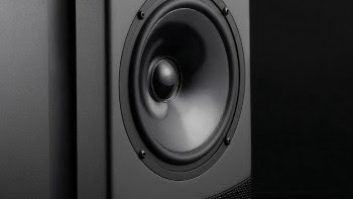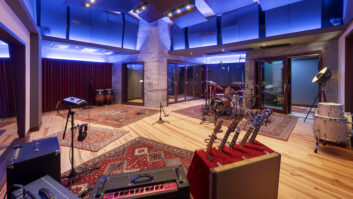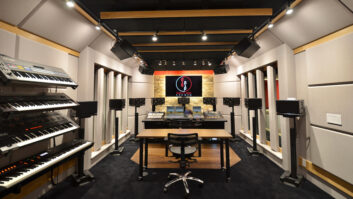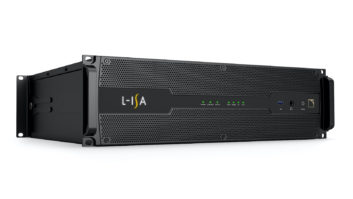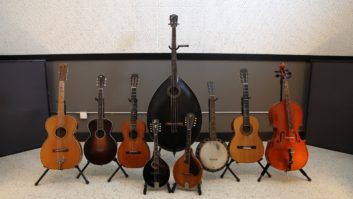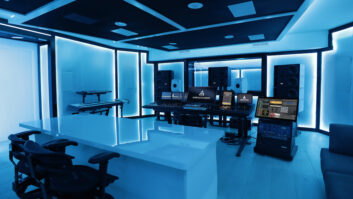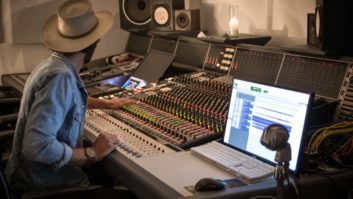
North Salt Lake City, UT—Jim Funk had been recording orchestrations used on Broadway and in touring musical productions for more than 15 years when he took the plunge and began building his own facility. “We said, ‘Let’s build a room that we haven’t had in the past—something that hopefully will also be attractive to people who are doing scores,’” says Funk.
The result of that ambition is the main tracking room at Funk Studios. Studio A, better known simply as The Stage, is big: 1,300 square feet, with 23-foot ceilings, custom variable acoustics and four iso booths, one housing a Yamaha C7 grand piano with Disklavier. “You can tune the walls to be more reflective or more absorptive,” says Stoker White, a recording engineer who works for The MT Pit, Funk’s long-established musical theater production track recording business.
The control room, also large, features a Solid State Logic Duality Delta Pro-Station SuperAnalogue mixing console, an LCR set of soffited ATC SCM110ASL Pro loudspeakers, a pair of ADAM Audio A77X midfields and racks of outboard gear. “I love the way it feels like a traditional analog desk, where everything is primarily accessible right on the channel strips instead of going back and forth to the center section,” White says of the Duality desk.
“The console mic pre’s sound excellent,” he continues. “I’ve used them for 80 percent of my work since we’ve been open. They’re perfect for the orchestral tracking we’re doing.” He engages the Variable Harmonic Drive (VHD) mic preamp circuit quite often when tracking drums, he says.
“I thought ATC speakers were out of reach,” says Funk, “until a phone call one night, and all of a sudden there they were. They’ve been beautiful in there, and a great addition.”
Related:
• Waterman Sound Goes with the Flow, by Steve Harvey, Jan. 14, 2020
• Big Bad Sound Flourishes in Mid-Market Niche, by Steve Harvey, July 27, 2018
The ADAM monitors are on the meter bridge all the time, White reports. “There are engineers who work strictly on those because they don’t like big soffit speakers, so they get worked on regularly.”
The nearfield monitors, cabling and other items were purchased from Performance Audio in Salt Lake City. “They have been great friends over the years and have always supported me in my craziness,” Funk says.
He’s also had a long relationship with Gadget Hopkins, executive vice president of Westlake Pro in Los Angeles. Hopkins introduced him to Jerry Steckling of JSX Audio, whom Funk hired to design the new complex, which was completed in early 2018. The building also houses The MT Pit’s operations. “We’ve got a bit more than 9,000 square feet here, and part of that is offices for the staff, a conference room and some extras,” says Funk.

The complex was originally conceived with two studios but has since expanded to three. Funk works primarily out of Studio B, which is set up for composing with keyboards and soft synths. Studio B was the first room to feature an SSL, an XL-Desk, he reports. “We thought it would be cool to have some flexibility on a smaller desk and have some different pre’s and EQs and whatever we wanted in there, because certain clients might be API or Neve snobs. I bought it more than a year before the Duality.”
The third room, Studio C, is typically occupied by freelance recording and mixing engineer Michael Greene, a veteran of the Los Angeles and Salt Lake City studio scenes. The room accommodates immersive IMAX 12.0 and Dolby Atmos 7.1.4 mixing projects as well as overdubbing. The room also has its own iso booth, equipped with a Yamaha grand piano, plus tielines to The Stage.
Greene has a long list of orchestral and ensemble recording projects to his name and has tracked a good number of them in Studio A, including jazz records and film and videogame scores. “The console sounds super warm and clear,” he says of the Duality. “It has a lot of warmth and bigness, but it still has a lot of clarity, without being harsh. I love having filters and EQs on every channel, and that when I put them in, they just sound great. And I like the flexibility of being able to build multiple cue mixes for the players with a minimum amount of fuss.”
Of course, the environment also plays a part. “Jerry has made something stunning and beautiful with both the control room and the studio,” says Greene. “Jim and Jerry have built a really special room—one of those rare rooms where everything shines and sounds beautiful.”
But wait, there’s more. “We’re working—very, very slowly—on a D room,” Funk reveals. That room will be for voiceover work, which currently takes place in the B room’s iso booth, often over Source-Connect. “Studio D could even handle a vocal or guitar project,” he says.
For added flexibility, the rooms are wired for SDI video and USB distribution. “We have a bunch of small cameras and can provide visibility from any room to anywhere,” says White. A couple of carts, each with a display, computer keyboard and mouse, can be patched into the A and B rooms. “You can plug them into the wall and control the room from either the floor of the stage or an iso booth,” says White. “Jim wanted to be able to work on his computer from out by the grand piano, so the infrastructure is there.”
The facility is well equipped; Funk has been collecting gear for years. “I had 110 mic pre’s before we bought the Duality, and different compression and EQ options. We have all kinds of outboard flavors,” he says.
As might be expected at a facility that focuses on orchestral recording, the mic locker is deep and wide, and includes a prized pair of vintage 67s with consecutive serial numbers. “Those are beautiful,” says Funk. “We have the modern one as well. There’s a slight difference, but they’re close enough that with a slight EQ, you would fool the best of us. We also have lots of ribbons, and we have seven mics from David Bock that we really love. And we’ve got a Lucas CS-1—those are rare. About 300 of those were made. It’s like an [AKG] C12. They’re beautiful mics.”
He adds, “We’ve just got a great assortment. You can accomplish whatever you want with what’s in the locker.”
Funk Studios • www.funkstudiosutah.com
The MT Pit • themtpit.com
Performance Audio • www.performanceaudio.com
JSX Audio • www.jsxaudio.com/profiles/steckling.htm
